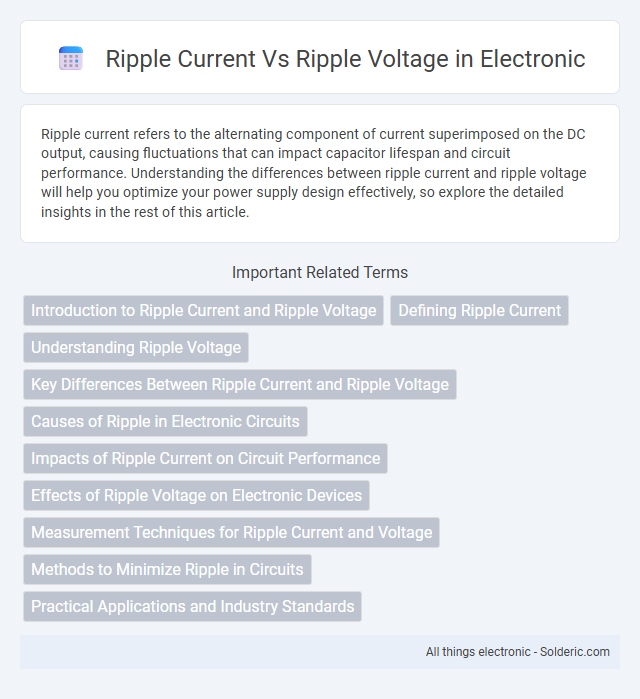Ripple current refers to the alternating component of current superimposed on the DC output, causing fluctuations that can impact capacitor lifespan and circuit performance. Understanding the differences between ripple current and ripple voltage will help you optimize your power supply design effectively, so explore the detailed insights in the rest of this article.
Comparison Table
| Aspect | Ripple Current | Ripple Voltage |
|---|---|---|
| Definition | AC component of current superimposed on DC load current | AC variation superimposed on the DC output voltage |
| Measurement | Measured in amperes (A), typically in mA to A range | Measured in volts (V), typically millivolts to volts |
| Source | Switching power supplies, converters, inductor current variations | Output voltage fluctuations from power supply, capacitors, or load changes |
| Impact | Reduces capacitor life, causes heating, affects EMI | Causes noise in circuits, reduces signal quality, affects performance |
| Filtering | Inductors, capacitors used to smooth current ripple | Capacitors and voltage regulators reduce voltage ripple |
| Typical Frequency Range | Switching frequency and its harmonics, typically kHz to MHz | Base switching frequency ripple, typically Hz to kHz |
| Common Measurement Tools | Current probes, oscilloscopes with current sensors | Oscilloscopes, voltmeters with AC measurement mode |
Introduction to Ripple Current and Ripple Voltage
Ripple current refers to the alternating current component that flows through electronic components, especially in power supplies and capacitors, while ripple voltage describes the fluctuations in voltage superimposed on the DC output of a power supply. Understanding ripple current is crucial for ensuring capacitor longevity and reliable circuit performance, as excessive ripple current can cause overheating and damage. Your choice of components must consider both ripple current and ripple voltage specifications to optimize the stability and efficiency of power electronics systems.
Defining Ripple Current
Ripple current refers to the alternating component of current superimposed on the DC load current within electronic circuits, causing periodic fluctuations that impact the performance and lifespan of components such as capacitors and inductors. It is a crucial parameter in power supply design, where excessive ripple current can lead to increased heat generation and potential failure of components. Understanding and managing ripple current ensures your circuits maintain stability and efficiency by minimizing these unwanted variations.
Understanding Ripple Voltage
Ripple voltage refers to the residual periodic variation of the DC voltage within a power supply after rectification and filtering. It represents the AC components superimposed on the DC output, often measured as peak-to-peak voltage or root mean square (RMS) value. Understanding your ripple voltage is crucial for designing power systems, as excessive ripple can cause interference, reduce efficiency, and damage sensitive electronic components.
Key Differences Between Ripple Current and Ripple Voltage
Ripple current refers to the alternating current component superimposed on the direct current in power supplies, causing fluctuations in current flow, while ripple voltage signifies the small, undesirable AC voltage variations that appear on the output DC voltage. Ripple current primarily affects the thermal stress and lifespan of components such as capacitors and inductors, whereas ripple voltage impacts the stability and noise performance of electronic circuits. Understanding these key differences is essential for optimizing power supply design, ensuring component reliability, and minimizing electromagnetic interference.
Causes of Ripple in Electronic Circuits
Ripple current and ripple voltage in electronic circuits are primarily caused by the incomplete filtering of AC components from a rectified DC signal. Factors such as load variations, switching frequency, and the quality of filtering components like capacitors and inductors directly influence the magnitude of ripple. Understanding these causes helps you design circuits with better noise suppression and improved power stability.
Impacts of Ripple Current on Circuit Performance
Ripple current significantly affects circuit performance by causing additional heat generation in components such as capacitors and inductors, which can reduce their lifespan and reliability. High ripple current leads to increased electromagnetic interference (EMI), potentially disturbing sensitive circuit elements and degrading overall signal integrity. Managing ripple current effectively ensures Your circuit operates efficiently and maintains stability under varying load conditions.
Effects of Ripple Voltage on Electronic Devices
Ripple voltage causes fluctuations in the power supply voltage, potentially leading to malfunction or reduced performance in electronic devices. It can induce noise, affecting sensitive components like microcontrollers and amplifiers, and may accelerate wear in capacitors and other passive elements. Ensuring stable voltage by minimizing ripple voltage is critical for preserving the longevity and reliability of your electronic equipment.
Measurement Techniques for Ripple Current and Voltage
Accurate measurement of ripple current involves using a current probe or a shunt resistor connected to an oscilloscope to capture high-frequency current variations in electronic circuits. Ripple voltage measurement typically employs an oscilloscope with a differential probe or high-impedance voltage probe placed directly across the component or load to observe voltage fluctuations. Ensuring proper grounding, probe calibration, and bandwidth selection is essential for reliable results when assessing ripple characteristics in power supplies or filtering applications.
Methods to Minimize Ripple in Circuits
Minimizing ripple current involves using larger filter capacitors, low-ESR capacitors, and proper layout techniques to reduce high-frequency noise and heat dissipation. To reduce ripple voltage, designers implement LC or RC filters, voltage regulators, and careful selection of components to stabilize output voltage levels. Your circuit's efficiency and longevity improve significantly by combining these methods to manage both ripple current and ripple voltage effectively.
Practical Applications and Industry Standards
Ripple current and ripple voltage are critical parameters in power electronics, particularly in designing capacitors and filters for power supplies and DC-DC converters. Industry standards like IEC 61000 and JEDEC define maximum permissible ripple current and voltage levels to ensure reliability and longevity in applications such as automotive electronics, renewable energy systems, and consumer devices. Understanding these parameters helps you optimize component selection and circuit design to meet practical performance and regulatory requirements effectively.
ripple current vs ripple voltage Infographic

 solderic.com
solderic.com